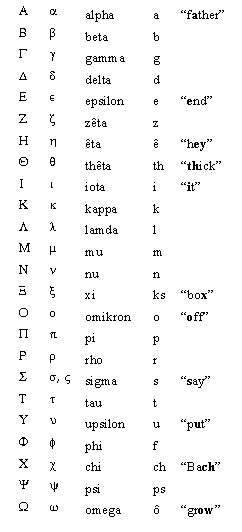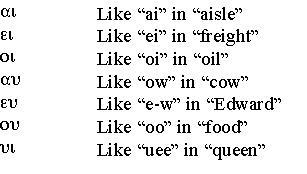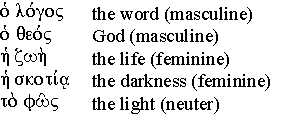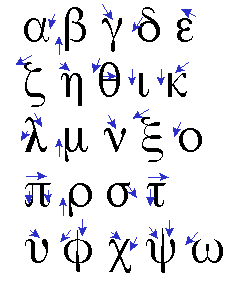
This table gives the Greek letters, their names, equivalent English letters, and tips for pronouncing those letters which are pronounced differently from the equivalent English letters. (There are actually several acceptable ways to pronounce New Testament Greek. For the gory details, look here.)

Sigma (s, V):There are two forms for the letter Sigma. When written at the end of a word, it is written like this: V. If it occurs anywhere else, it is written like this: s.
Upsilon (u):In the above table, we suggest that you pronounce this letter like "u" in "put". The preferred pronunciation is actually more like the German "ü" as in "Brücke", or like the French "u" as in "tu". If you do not speak German or French, don't worry about it, just pronounce it the way the table suggests.
Xi (c): This is the same sound as "ch" in "Bach", which does not sound like "ch" in "chair". The same sound occurs in the Scottish "Loch", as in "Loch Lomond", or the German "ach!".
Dipthongs When two vowels combine to make one sound, it is called a dipthong. There are seven dipthongs in Greek:

The "eu" combination is probably the hardest to learn for most people. It may help to take the "ow" sound and say it slowly: if you notice, there are actually two sounds in "ow" - it starts out with "ah", then glides to an "oo" sound, "ah-oo". Try doing the same with "e" (as in "edward") and "oo" - "e-oo". This is a little like the "e-w" in Edward, if you remove the "d".
Clip and save! You may want to print out this table and glue it to the inside cover of your Greek dictionary. If you are ever in doubt about alphabetic order, this will help you look up words. If you have difficulty with pronunciation, you could also print it out and glue it to the inside of your Greek New Testament.
Accents tell you which syllable is stressed when the word is pronounced. There are three different accents, but by the time of the New Testament, they were all pronounced the same. Here are the three kinds of accents, with a Greek word to illustrate each:

The rough breathing is pronounced like an "h", and looks like a backwards comma written over a vowel. The smooth breathing is not pronounced at all, and looks like a regular comma written over a vowel. Note the difference between "en" and "hen":

There are two marks over the epsilon in "hen"; the first is the rough breathing, the second is the accent.
A vowel at the end of a word will sometimes have an "iota subscript" underneath it; here is an alpha with an iota subscript:
![]()
The iota subscript is not pronounced, but it can be helpful for identifying certain grammatical forms that we will learn about later (especially the dative case).
The period and comma are the same as in English. The semicolon is a raised dot, and is also used as a colon. The question mark looks like an English semicolon:



![]()

Did you ever dream of working as a file clerk in ancient Greece? No? Well, did you ever dream of being able to look up words in a Greek dictionary? In either case, you are going to have to learn the order of the Greek alphabet. I've made up a mnemonic which may be helpful for some people:
| a b g d e | All Bigots Get Diarrhea Eventually |
| z h q i k | Zorro Ate THe Ice Kap(pa) |
| l m n x o | Let's Munch Nuts EXcessively, Okay? |
| p r s t | Pigs Really Stink Terribly |
| u f c y w | Under Five CHairs, PSychiatrists Wink |
If you use this mnemonic, remember that "Chairs" is not really the way to pronounce c, which sounds like "ch" in "Bach". Some people prefer to learn the order based on differences from the order of the English alphabet:
| a b g d e | Same as English, except for the gamma |
| z h q i | zhqi means "live!" in Greek. |
| k l m n x o | Same as English, except for xi. |
| p r s t u | Same as English, but no "q" |
| f c y w | Memorize these, or use the mnemonic from the above table. |
The arrows show you where to start when you write Greek letters. Always remember to write the accents and breathing marks, as well as the iota subscripts!

To be fair, we should mention that there are several different ways to pronounce Greek. We are teaching the Erasmian pronunciation for now. At some point in the future, we may add pages to teach some of the other pronunciations. Here are the main ways that Greek is pronounced: